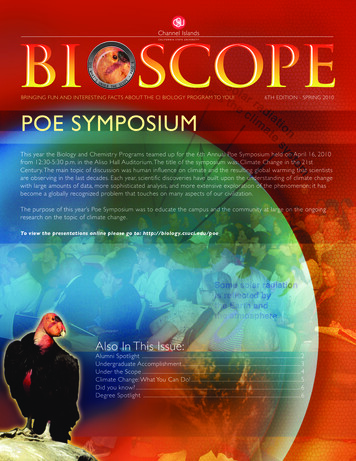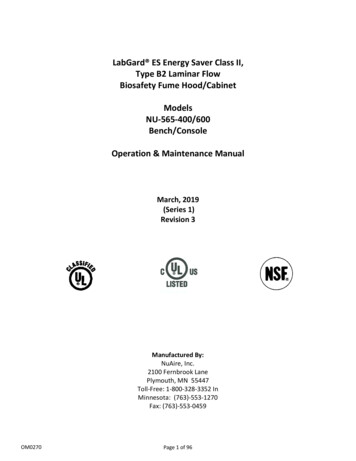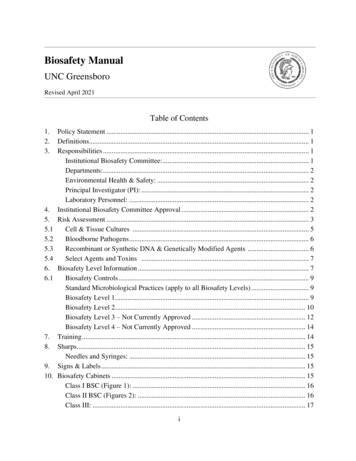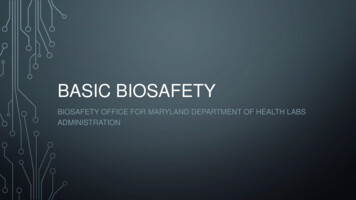
Transcription
BASIC BIOSAFETYBIOSAFETY OFFICE FOR MARYLAND DEPARTMENT OF HEALTH LABSADMINISTRATION
COURSE OUTLINE1.2.3.4.5.IntroductionBiosafety LevelsPPE requirementsBiological Waste Management at the MDH LabsEmergency Response Procedures
WHAT IS BIOSAFETY?According to the WHO (World Health Organization), biosafety is the use ofcontainment principles, technologies, and best practices to preventunintentional exposure to pathogens and toxins, or their accidentalreleaseBiosafety is a PRACTICE: Biosafety practices are used in the properhandling of biohazardous organisms. Human, animal and plant materialsmay harbor biohazardous organisms or agents and such materials mustbe handled accordinglyBiohazardous organisms are microorganisms with an infectious potentialfor man, animals, and plants in the environment. These microorganismsinclude prokaryotic and eukaryotic microbes, viruses, sub-viral infectiousagents and recombinant organisms with any potential for survival in theenvironment or in living materials and can cause a health risk
WHAT IS THE PURPOSE OF THIS COURSE? To provide a basis for the implementation of aBIOSAFETY CULTURE at the MDH LaboratoriesAdministration To ensure awareness of proper PPE, bestpractices, and MDH guidelines for LaboratoriesAdministration workers To provide new employees with a basic knowledgeof biosafety and provide refresher training forcurrent employees
BIOSAFETY LEVELSBSL-1: Organisms that typically do not causedisease in healthy adults and pose minimalrisk outside the laboratory environment (e.g.Saccharomyces cerevisiae, non-diseasecausing E. coli) – can be handled at BSL-1laboratories Access limited to necessary personnel, noeating/drinking, etc. inside laboratory, manipulationsof organisms can occur safely on benchtop
BIOSAFETY LEVELS (CONT.)BSL-2: Organisms that pose a moderate risk to employees, may cause milddisease in healthy adults – must be handled at BSL-2 laboratories Manipulations of organisms may be performed on bench top, but any procedure likely to causeaerosols (e.g. vortex, pipette, culture plates, etc.) should be performed inside a BSC Additional access controls, medical surveillance for staff, are advised for BSL-2 LabsPersonal Protective Equipment (PPE) requirements are lab coat or gown, safety goggles andor face mask, and disposable glovesNote: Most of the work done at MDH Labs is performed within the BSL-2laboratory. Consult with supervisor or Division Chief for specificrequirements.
BIOSAFETY LEVELS (CONT.)BSL-3: Organisms known to cause serious or fatal disease inhumans and pose a severe risk to the environment – must behandled in BSL-3 laboratories. These organisms can betransmitted via inhalation and are not readily treatable orpreventable with vaccination Manipulation of organisms must be performed in a secure BSL-3 laboratoryand in a Biosafety Cabinet (BSC). Additional PPE is required for all workinside a BSL-3 Lab MDH Labs provides separate training for BSL-3. Access to BSL-3 labs atMDH is restricted to those who have completed proper trainingNote: Highest level is BSL-4 but this level is not in use at MDHLabs
PPE REQUIREMENTSUniversal Precautions States that: All biological material is to be treated as infectiousmaterial Blood and Other Potentially Infectious Materials (OPIM) Includes: blood, urine, sera, CSF, etc. Details are covered as a part of Bloodborne Pathogen training PPE signage is posted on all lab entry and exit doors
PPE REQUIREMENTSBSL-2: Minimum requirements in open andclosed labs are lab coats and eye protection Gloves are required for specific tasks and testingbased on unit SOPs Other requirements can include the use of a respirator,sleeves and double-gloves while working with specificmaterials/samples Full-face shields may also be used for specific tasksBSL-3: Respiratory protection (N-95 respiratoror PAPR), Tyvek suit (including shoeprotection), apron, sleeves and double gloves,and safety goggles and hair cover (if using N95)
ADDITIONAL INFORMATION FOR MDH LABSAll lab coats are to be kept inside the laboratory or lab corridor Observe all signs for where lab coats are allowed to be worn (e.g. No labcoats in the carpeted areas in the offices, etc.) Launder lab coats as needed Additional disposable lab coats are available in every unit as neededWash hands prior to exiting lab. Sinks are located near each exit doorfor ease of access
PREPARING TO USE A BIOSAFETY CABINET (BSC) Ensure that the BSC is within itscertification period Lift sash to height denoted on theside of the cabinet and turn on theblower Allow blower to re-circulate air andequilibrate for 4-5 min Check the air flow on the pressuregauge (minimum is 0.25 psi) and fillout daily maintenance log Disinfect all surfaces inside BSC withappropriate disinfectant (e.g. 10%bleach or Alcohol) prior to use, ifneeded
WORKING INSIDE A BSC Do not clutter the work area. Too manymaterials will inhibit the air flow Do not block the front grill or the reargrill to allow for proper circulation Place whatever supplies are neededinto the BSC prior to beginning work.Minimize movement in and out of thehood as it disrupts the air flow When moving in or out of the BSC,move slowly and perpendicular to thecabinet Try to work towards the center of thework area
FINISHING WORK IN THE BSC Place all waste materials inside biohazard container Upon completion of work, decontaminate materials to be removed fromcabinet, if necessary, using appropriate disinfectant Empty biohazard waste container, if necessary Wipe down ALL internal surfaces with appropriate disinfectant Close sash and turn off blower Turn on UV light and fill out the daily maintenance log for BSCIn the event of an emergency or power failure, secure the specimen/sample, then close the sash prior to leaving the area.
BSC Demonstration Video
WASTE MANAGEMENTBiohazard Waste All infectious materials must be disposed of in biohazard container It is recommended that biohazard bags are double bagged andsprayed down with appropriate disinfectant. All waste is to becollected in designated area Sharps are to be collected in designated sharps containers. When2/3rd full, please close the lid and dispose in a biohazard bags
WASTE MANAGEMENTChemical Waste No hazardous chemicals may be discarded down the drain at theMDH Laboratory Administration building All hazardous chemical waste generated as part of routinelaboratory testing must be collected in suitable, properly labeledcontainers, including the date of generation Once containers are 2/3rd full, waste pick-up must be arrangedthrough the Safety and Security Officer (SSO) Any outdated and expired chemicals must also be disposed ofand arranged through the SSORadiation Waste is collected and handled by the Radiation Safety Officer
DISINFECTION AND DECONTAMINATION All work surfaces should be disinfected before work is begun ANDafter work has been completed for the day Common disinfectants are: 10% Bleach-prepared by mixing 1 part household bleach with 9 parts water, orby using a bleach-dilution system (Ex. Activate Bleach system) Lysol-prepared according to manufacturer’s instructions Ethanol/Isopropanol Unit-specific disinfectants (e.g. LopHene) These chemicals can also be irritants and should be handled usingproper PPE (i.e. gloves)
EMERGENCY RESPONSE PROCEDURESBIOLOGICAL SPILL CLEAN-UP Every Division or Unit is equipped with a Biological Spill Kit. Allemployees should be aware of its location within their specificunit The spill-kit contains the SOP and supplies required for spillclean-up. Use the Spill Clean-up SOP for detailed procedures.Hands-on training for Spill Clean-up may be recommended foreach individual unit Any spill that occurs outside a BSC requires notification toSSO After use of spill kit, please replace the contents (contact SSOor BSO, if necessary)
1) Wait 30 min for aerosolsto settle. Place sign ondoor to lab. Obtain spill kitand don new PPE, ifneeded.2) Beginning from theoutside, cover the spillwith absorbentmaterials.4) Carefully working fromedge to center, collectabsorbent materials intobiohazard waste container.5) If necessary, placemore absorbentmaterials anddisinfectant for another20 min.3) Carefully pour appropriatedisinfectant on absorbent materialsand wait 30 min (or recommendedcontact time).6) Place all materials, including PPE, inbiohazard waste bag. Place biohazardwaste bag into biohazard container fordisposal.
Warning Sign to use to place on door during Spill Clean Up. Onesign is available in each spill kit.
INCIDENT RESPONSE – EXPOSURE TOBIOLOGICAL PATHOGEN For accidents, needle sticks, etc. Remove contaminated PPE Flush the exposed body area with clean water for 15-20 min Contact Supervisor/Director/SSO immediately Begin “First Report of Injury Form” Employee is referred to current State healthcare provider for bloodsample collection and prophylaxis as needed Retain sample of infectious source material for further testing, as needed
TWELVE VALUABLE RULES OF BIOSAFETY1.SUPERVISORS MUST PROPERLY TRAIN THEIR EMPLOYEES BEFORE PERMITTINGTHEM TO CONDUCT BIOHAZARDOUS WORK2.KNOW AND UNDERSTAND THE BIOLOGY AND INFECTIOUS POTENTIAL OFBIOHAZARDOUS AGENTS YOU HANDLE3.HANDLE ALL BIOLOGICAL MATERIAL (TISSUES AND BODY FLUIDS) RECOGNIZED TO BECAPABLE OF POTENTIALLY HARBORING BIOHAZARDOUS ORGANISMS ORAGENTS AS IF THE INFECTIOUS AGENT IS PRESENT4.ALWAYS USE GOOD STANDARDS OF MICROBIOLOGICAL PRACTICE IN HANDLINGBIOHAZARDOUS AGENTS OR MATERIALS OR ANY MICROORGANISM5.USE THE BIOSAFETY LEVEL CONTAINMENT AND PRACTICES SPECIFIED FOR THEINFECTIOUS AGENT BY THE CENTERS FOR DISEASE CONTROL ANDPREVENTION, ATLANTA, GEORGIA6. DO NOT WORK WITH A MICROORGANISM OR AGENT IF THE REQUIRED LEVEL OFPHYSICAL CONTAINMENT DESIGNATED FOR THE BIOHAZARDOUS MATERIAL BEINGUSED IS NOT AVAILABLE
TWELVE VALUABLE RULES OF BIOSAFETY7.EACH WORKER HANDLING BIOHAZARDOUS MATERIAL IS RESPONSIBLE FORFOLLOWING SAFETY RULES TO PREVENT INJURY TO SELF AND OTHERS8.VIGILANCE AND MONITORING OF BIOSAFETY PRACTICES ARE ESSENTIAL IN ANYBIOSAFETY PROGRAM9.ASSUME THAT ACCIDENTS WILL OCCUR AND PLAN FOR SAFELY MANAGING THOSEEVENTS WHEN HANDLING BIOHAZARDOUS MATERIALS AND AGENTS10. REPORT ALL ACCIDENTS OR INCIDENTS TO YOUR SUPERVISOR IMMEDIATELY11. USE DISINFECTANTS OR STERILANTS WITH PROVEN EFFICACY AGAINST THESPECIFIC BIOHAZARDOUS AGENT(S) YOU ARE USING12. NEVER PERMIT BIOHAZARDOUS MATERIALS TO LEAVE THE LABORATORYUNSTERILIZED UNLESS BEING TRANSPORTED TO ANOTHER LABORATORY FORADDITIONAL WORK AND PACKAGED ACCORDING TO APPROPRIATE REGULATIONS
QUIZhttps://www.surveymonkey.com/r/Biosafety Knowledge QUIZ
CONTACT INFOSecurity and Safety Officer (SSO):W: 443-681-3792Biological Safety Office (BSO):W: 443-681-3870W: 443-681-5187
REFERENCES Biosafety in Microbiological and Biomedical Laboratories, currentedition, https://www.cdc.gov/biosafety/publications/bmbl5/ Principles of Biosafety Fact Sheet, Association for Biosafety andBiosecurity BSC Training video from National Institutes of Health (NIHOD)
COURSE OUTLINE 1. Introduction 2. Biosafety Levels 3. PPE requirements 4. . of biosafety and provide refresher training for current employees. BIOSAFETY LEVELS. BSL-1: Organisms that typically do not cause . Radiation Waste is collected and handled by the Radiation Safety Officer.
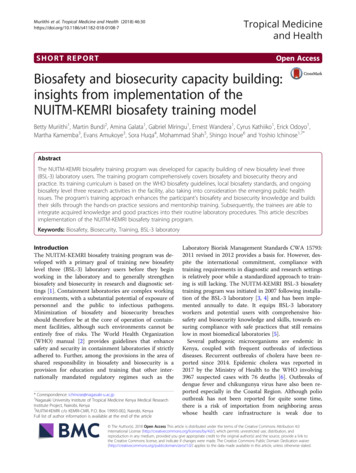
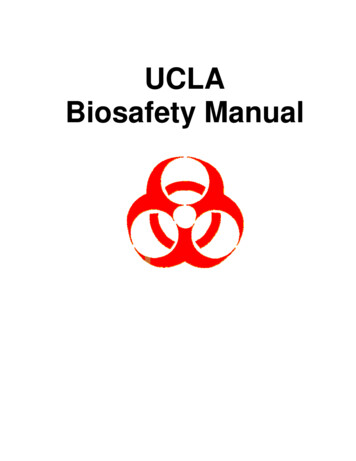
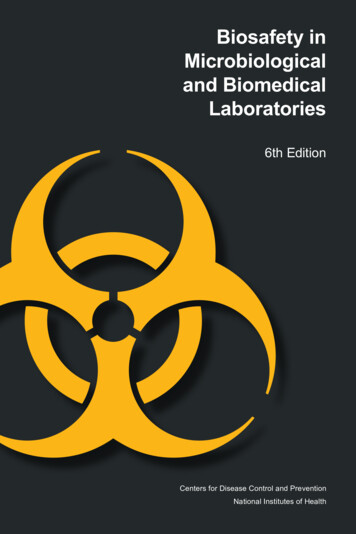
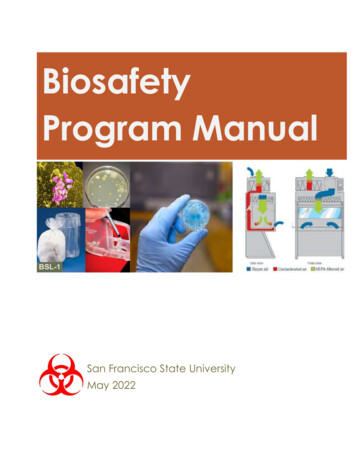

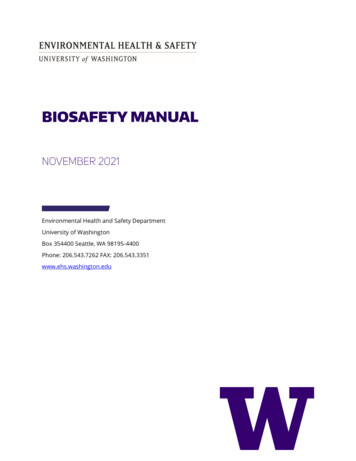
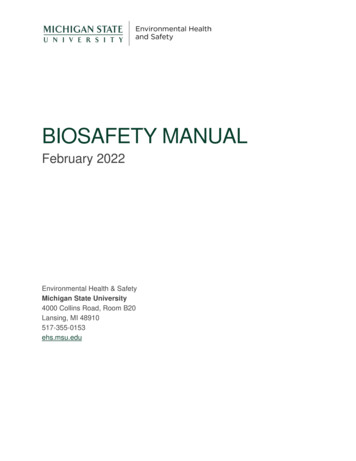
![Biosafety Manual University of Colorado Boulder 120621[80]](/img/25/biosafety-manual-university-of-colorado-boulder.jpg)
